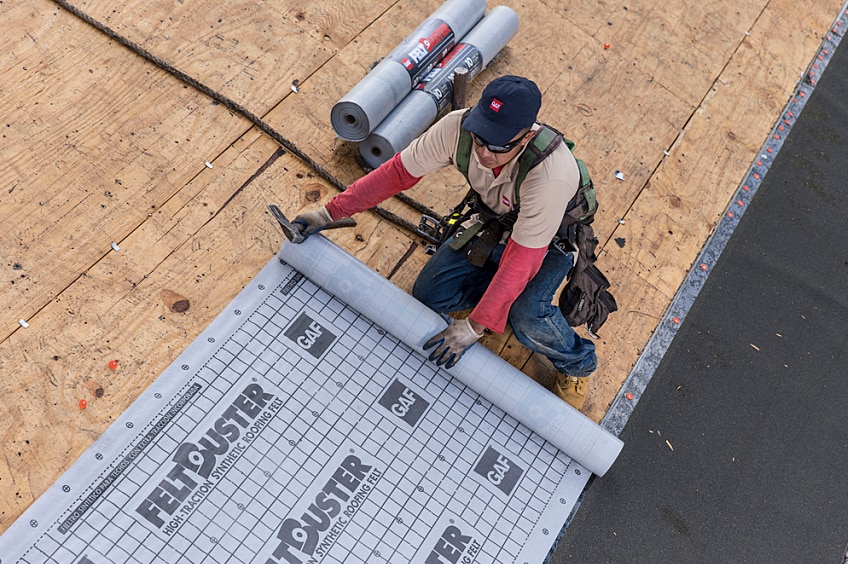Most homeowners don't think about all the components that make up the roof of their home, but there's a lot going on underneath your shingles.
The shingles are the outermost layer of your roof and they help protect you from the sun's rays, rain, snow, and wind. Digging deeper, there's another layer of protection between the roof deck and the shingles: underlayment, which plays a vital role in helping protect your home from moisture damage.
What Is Roof Underlayment, and Why Is It Important?
This layer of your roof system is typically made of asphalt saturated felt or modern synthetic materials. It covers your entire roof deck, acting as a secondary moisture barrier between the roof deck and the overlying shingles (or other roof covering) to help prevent wind-driven rain from infiltrating your home through the roof.
In other words, it helps keep your home dry. It's just one of many layers of materials that make up your roofing system, and all of them have to be installed properly for your roof to provide the best protection against the elements.
What Are the Different Types of Roof Underlayment?
Roof underlayment is usually made of either asphalt-saturated felt or synthetic materials. In either case, it provides a secondary water-shedding layer of protection that helps keep water during a rain event from infiltrating your home. GAF offers several types of roofing underlayment for different types of homes and price points.
Deck-Armor™
Combining strength with it's premium breathable technology, Deck-Armor™ Premium Roof Deck Protection helps protect your home from wind-driven rain and trapped moisture. Trapped moisture can lead to the growth of mold, mildew, or rot, which can result in damage to your roof system. This lightweight, slip-resistant roofing underlayment is easy for workers to install, even on steeply pitched roofs. It's breathable technology makes it an excellent choice for premium roof systems.
Tiger Paw™
Tiger Paw™ Roof Deck Protection is a premium, UV-stabilized synthetic roof underlayment with a moisture-control design that helps to reduce moisture on the roof deck and provide a strong layer of protection against wind-driven rain that can damage your roof structure or home interior. Recommended for asphalt shingles, slate, wood, metal, or mechanically-attached tile roofs, this layer combines strength and resilience, so it won't rot or get brittle. It also resists buckling to give your roof a smooth appearance and is specially designed to provide excellent walkability for roofers.
FeltBuster®
The value-priced FeltBuster® Synthetic Roofing Felt is a polypropylene underlayment. Its durable construction helps it resist tearing and it won't absorb moisture that can lead to disintegration over time. It lies flatter than typical felt for a sleek looking roof.
Shingle-Mate®
For another fiberglass-reinforced roofing felt option, Shingle-Mate® Fiberglass-Reinforced Roof Deck Protection acts as a secondary layer of protection against wind-driven rain. Conventional asphalt felts can bubble or wrinkle when they come in contact with moisture, which can detract from the look of your finished roof. Shingle-Mate's fiberglass reinforcement helps it lay flat and reduces wrinkling for a great finished look.
VersaShield®
VersaShield® Fire-Resistant Roof Deck Protection helps many roofing systems achieve a high UL fire rating* while providing a secondary layer of protection against wind-driven rain. The fiberglass reinforcement helps keep it flat for a great finished look.
GAF roof deck protection qualifies for a Lifetime limited warranty when installed with additional qualifying products**. Find a contractor certified by GAF*** in your area to discover the various products that are available for your home.
*Please refer to Underwriters Laboratories Certifications Directory for actual assemblies.
** Lifetime refers to the length of warranty coverage provided and means as long as the original individual owner(s) of a single-family detached residence [or eligible second owner(s)] owns the property where the qualifying GAF products are installed. For other owners/structures, Lifetime coverage is not applicable. Lifetime coverage on shingles requires the use of GAF Lifetime Shingles only. Lifetime coverage on shingles and accessories requires the use of any GAF Lifetime Shingle and at least 3 qualifying GAF Accessories. See GAF Roofing System Limited Warranty for complete coverage and restrictions. Visit gaf.com/LRS for qualifying GAF products. For installations not eligible for the GAF Roofing System Limited Warranty, see the GAF Shingle & Accessory Limited Warranty.
***Contractors enrolled in GAF certification programs are not employees or agents of GAF, and GAF does not control or otherwise supervise these independent businesses. Contractors may receive benefits, such as loyalty rewards points and discounts on marketing tools from GAF for participating in the program and offering GAF enhanced warranties, which require the use of a minimum amount of GAF products.




